

Constructivism as a Paradigm for Teaching and Learning. What is constructivism?

How does this theory differ from traditional ideas about teaching and learning? What does constructivism have to do with my classroom? Expert Interview What is the history of constructivism, and how has it changed over time? What are some critical perspectives? What are the benefits of constructivism? What does constructivism have to do with my classroom? As is the case with many of the current/popular paradigms, you're probably already using the constructivist approach to some degree.
Harvard EdCasts. Cultures of Thinking. For more information, please see the Visible Thinking website.
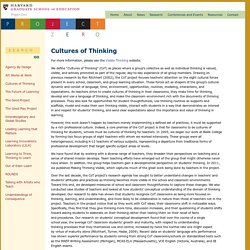
We define “Cultures of Thinking” (CoT) as places where a group’s collective as well as individual thinking is valued, visible, and actively promoted as part of the regular, day-to-day experience of all group members. Drawing on previous research by Ron Ritchhart (2002), the CoT project focuses teachers’ attention on the eight cultural forces present in every school, classroom, and group learning situation. These forces act as shapers of the group’s cultural dynamic and consist of language, time, environment, opportunities, routines, modeling, interactions, and expectations. As teachers strive to create cultures of thinking in their classrooms, they make time for thinking, develop and use a language of thinking, and make the classroom environment rich with the documents of thinking processes.
Visible Thinking. Purpose and Goals Visible Thinking is a flexible and systematic research-based approach to integrating the development of students' thinking with content learning across subject matters.

An extensive and adaptable collection of practices, Visible Thinking has a double goal: on the one hand, to cultivate students' thinking skills and dispositions, and, on the other, to deepen content learning. By thinking dispositions, we mean curiosity, concern for truth and understanding, a creative mindset, not just being skilled but also alert to thinking and learning opportunities and eager to take them Who is it for?
Visible Thinking is for teachers, school leaders and administrators in K - 12 schools who want to encourage the development of a culture of thinking in their classrooms and schools. Key Features and Practices At the core of Visible Thinking are practices that help make thinking visible: Thinking Routines loosely guide learners' thought processes and encourage active processing. License. Nonacademic Skills Are Key To Success. But What Should We Call Them? : NPR Ed. More and more people in education agree on the importance of learning stuff other than academics.
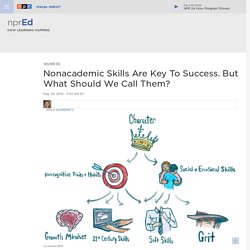
But no one agrees on what to call that "stuff". There are least seven major overlapping terms in play. 4 Tools to Help Create Interactive Classroom Content. Dr. Karen’s Foolproof Grant Template. NOTE: An expanded and updated version of this post can now be found in Chapter 51 of my new book, The Professor Is In: The Essential Guide to Turning Your Ph.D.
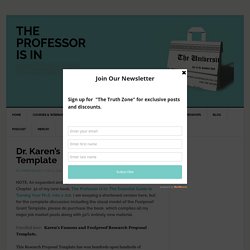
Into a Job. I am keeping a shortened version here, but for the complete discussion including the visual model of the Foolproof Grant Template, please do purchase the book, which compiles all my major job market posts along with 50% entirely new material. 5 Tips To Improve Your Academic Writing And A Grammar Infographic. PowerPoint Templates, Transitions & Animations. Module 3. Connectivism. Connected Learning. Blended Learning. Blended Learning. Connected Learning. American Council of Learned Societies. The deadline for this program has passed.
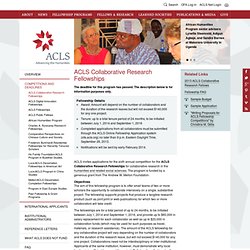
The description below is for information purposes only. Fellowship Details Award: Amount will depend on the number of collaborators and the duration of the research leaves but will not exceed $140,000 for any one project.Tenure: up to a total tenure period of 24 months, to be initiated between July 1, 2014 and September 1, 2016Completed applications from all collaborators must be submitted through the ACLS Online Fellowship Application system (ofa.acls.org) no later than 9 p.m. Eastern Daylight Time, September 26, 2013.Notifications will be sent by early February 2014. Objectives The aim of this fellowship program is to offer small teams of two or more scholars the opportunity to collaborate intensively on a single, substantive project. Eligibility The Project Coordinator must have an appointment at a U.S. Application Process – please review carefully One member of the project team must be designated as the Project Coordinator (PC).
Evaluation. PowerPoint in higher education is ruining teaching. Www.usciences.edu/teaching/Learner-Centered/Blumberg_Developing_Learner_Centered_Teaching.pdf. Learner-Centered Teaching. Learner-Centered Teaching Phyllis Blumberg, Ph.D.

Director of the Teaching and Learning Center University of the Sciences in Philadelphia 1. Most of this material comes from Blumberg, P. (2008) Developing Learner-Centered Teachers: A Practical Guide for Faculty. San Francisco: Jossey-Bass. This site contains links to presentation or workshops I have done at various places over the past few years. Versions of most of these workshops have been offered repeatedly to new faculty at the University of the Sciences, at the Lilly Conference, The Teaching Professor Conference, the POD Network conference and to faculty at various colleges and universities in the USA and around the world and trainers for the United States Army. • Implementing Learner-centered approaches in your teaching. PowerPoint in higher education is ruining teaching. Workshops, University of Cincinnati. Summer 2014 Build a Better Resume and Cover Letter Date and time TBA.

The most frustrating part of any job search is submitting a ton of applications, only to get no response. So what does it take to get an interview? The key is your resume* and cover letter. This workshop will show you how to take your resume and cover letter to the next level, so that the documents you submit with your job applications will prompt search committees to invite you for an interview. In order to register for this workshop, you must: upload your current resume,link to a job posting—either something you plan to apply for or (if you are not currently searching for a job) the type of position you will apply forupload a cover letter written for the job posting As this workshop will provide individual attention to each person’s resume and cover letter, the workshop is limited to 10 participants per session.
Assessing Student Relationships. National Council on Teacher Quality. Publications. Web.ics.purdue.edu/~drkelly/DFWKenyonAddress2005.pdf. Strengthening systems would improve public higher education (essay) Chancellor Nancy Zimpher of the State University of New York (SUNY) has added a new word to Wikipedia.
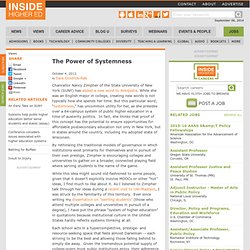
While she was an English major in college, creating new words is not typically how she spends her time. But this particular word, “systemness,” has uncommon utility for her, as she presides over a 64-campus system of public higher education in a time of austerity politics. In fact, she thinks that proof of this concept has the potential to ensure opportunities for affordable postsecondary education not only in New York, but in states around the country, including my adopted state of Wisconsin. Sites/default/files/idea_paper_51.pdf.